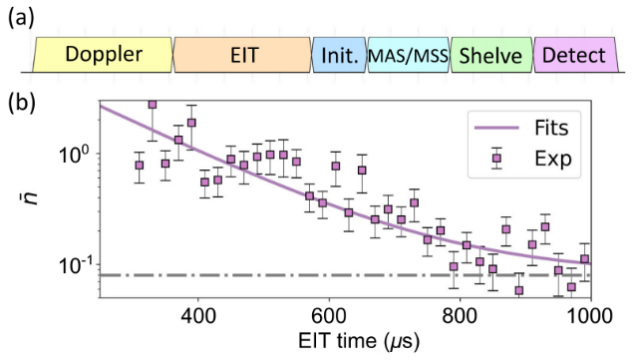Tsinghua Researchers Unlock Cooling Potential of High-Nuclear-Spin Ions
The research group led by Prof. Luming Duan at Tsinghua University has recently achieved a significant advance in the field of ground state cooling of ions with high nuclear spins. For the first time, electromagnetic induced transparency (EIT) cooling has been realized in Ba137 ions with a nuclear spin of 3/2. This scheme utilizes the spectral design of Fano like lines in the EIT effect, which enables simultaneous cooling of all phonon modes over a wide frequency range. The scheme can be applied to large-scale ion crystal with similar nuclear spin structures (I>1/2), solving an important obstacle for the application of ions with high nuclear spins in future large-scale ion quantum computing. The relevant research results were published in the Physics Review Letters under the title of “Electromagnetic Induced Transparency Cooling of High-Nuclear-Spin Ions”.
Ion trap is a powerful and multifunctional platform with wide applications in quantum information processing (QIP), precision spectroscopy, and fundamental physics testing.
In order to achieve high fidelity quantum information processing, researchers need to cool the relevant motional modes of ions to the lowest possible temperature. Electromagnetic Induction Transparency (EIT) cooling provides a faster cooling rate and wider cooling bandwidth, while maintaining a lower cooling limit(n¯≈0.1), making it a suitable cooling method for large ion crystal quantum computing and quantum simulation. However, for ions with high nuclear spin I>1/2 under low or moderate magnetic fields, it is challenging to achieve effective EIT cooling due to the difficulty in finding isolated Λ level structures.

Fig 1: Relevant energy structure of 137Ba+ and optic schemes
In this work, researchers demonstrated the use of 137Ba+ ions (I=3/2) for EIT cooling. The researchers modified the laser settings used for quantum bit state initialization to perform EIT cooling in open systems. Although all Zeeman energy levels in the S state are involved in the dynamics during the cooling process of EIT, the EIT pump beam also acts as a repump beam, keeping all states in the cooling subspace. Researchers experimentally cooled the two radial phonon modes of a single 137Ba+ion to an average phonon number of 0.08 and 0.15, respectively. By using the same laser parameters, the researchers further cooled all radial modes of the five ion chains to near the ground state.


Fig 2: Cooling results in single ion and a five-ions chain
This paper introduces an EIT cooling scheme suitable for ion species with high nuclear spins under low magnetic fields, and successfully implements the scheme on a single 137Ba+ion and a five-ion chain, achieving an average phonon number far below the Doppler cooling limit. This scheme can be naturally extended to other types of ions or atoms with high nuclear spins and provide an effective cooling mechanism for large-scale high nuclear spin ion crystals.
The first authors of this paper are Chuanxin Huang and Chenxi Wang, doctoral students from IIIS, Tsinghua University. The corresponding authors of the paper are Associate Researcher Zichao Zhou and Prof. Luming Duan. Other authors include IIIS Assistant Professors Yukai Wu and Panyu Hou, IIIS PHDl students Hongxuan Zhang, Hongyuan Hu, Zuqing Wang, Shijiao Li, and the HYQ company employee Dr. Zhichao Mao. This work was supported by the Innovation Program for Quantum Science and Technology (2021ZD0301601), the New Cornerstone Investigator Program, and the Tsinghua University Dushi program and start-up fund.

